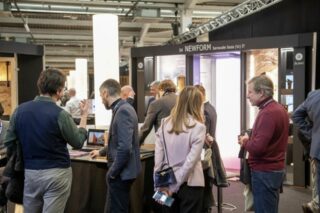Following last year’s well-received exhibition The Cinema, Tom Dixon spices up the design plate for visitors in The Restaurant. In partnership with leading quartz manufacturer Caesarstone, Dixon has designed four Caesarstone kitchens and dining halls for the delight of guests.
The Restaurant delivers a unique food concept at the city’s children’s museum MUBA in the Rotonda della Besana with a collection of recipes curated by Italian food design studio Arabeschi di Latte. Throughout the four kitchens, Dixon’s new Materiality range including Curve and Fade pendant lamps, mesmerizing Flask Oil candles and Offcut stools made dining a true pleasure.
ArchiExpo e-Magazine investigates the situation one kitchen at a time. We chat with British designer Tom Dixon, Caesarstone’s CEO Yos Shiran and Arabeschi di Latte; and, of course, we taste each dish to verify it qualifies as “haute cuisine.”
THE FOUR KITCHENS
“We used factories from France and the Netherlands to manufacture the products you see here,” Yos Shiran, CEO of Caesarstone, told ArchiExpo e-Magazine in an interview following the press preview. “What we produce are slabs. In this case the slabs were 3 meters long, 1.44 meters wide and about 20mm thick. Then the factories, qualified to cut to order, work the slabs into the design accordingly. Then a special team installed everything here in the museum.”
Caesarstone chose French company Pierredeplan to shape Dixon’s designs to perfection, stating the company is the very best for the job. Listen to Tom Dixon talk about Caesarstone products.
The interior of the museum sits like a cross, the perfect layout to separate the four kitchens. Each end of the ‘cross’ housed one of the four: the Air kitchen, the Earth kitchen, the Fire kitchen and the Water kitchen.
A true collaboration, Caesarstone and Dixon worked together to find the right combination of materials to fit the theme of the four elements, also in regards to location.
“We showed Tom the variety of colors we wanted him to use and he chose out of those; because we have over 70 colors, so we tried to narrow it down,” Kibbutz Sdot-Yam, Marketing VP, added.
Tom Dixon’s Choice
They decided on separating the four kitchens into elements. Listen to Tom Dixon explain in an interview with ArchiExpo how the collaboration with Caesarstone began, what it could have been and how it turned out.
“With the elements [air, fire, water, earth], you can do anything,” Dixon told ArchiExpo e-Magazine in an interview while sitting in the Fire Kitchen. “Color can go into one, a smell can go into one; it becomes very easy to divide Caesarstone into four elements. We can even divide the food into four elements.”
In the Fire Kitchen – Black Flat, the Caesarstone designs used: 5100 Vanilla Noir, 6003 Coastal Grey, 4120 Raven. Listen to Tom Dixon tell the story behind the Fire Kitchen.
In the Air Kitchen – Skyfruit, the Caesarstone designs used: 5211 Nobel Grey, 4004 Raw Concrete. Listen to Tom Dixon speak about the Air Kitchen.
In the Earth Kitchen – the Root Box, the Caesarstone designs used: 5380 Emperadoro, 8330 Albero, 5104 Tuscan Dawn.
In the Water Kitchen – Frozen “Stracciatella,” the Caesarstone designs used: 4001 Fresh Concrete, 5111 Statuario Nuvo, 6600 Nugat, 5130 Cosmopolitan White, 4003 Sleek Concrete. In the Water kitchen, the Electrolux Grand Cuisine Blast Chiller was used to freeze vegetables in a matter of minutes, a process that would normally take hours. Watch the video below.
Behind the Kitchen with Tom Dixon
“You can be a much better designer of a restaurant if you’ve worked in one,” Tom dixon stated during the press preview. The designer takes off his ‘master chef’ toque once a month and works at the “bottom of the pole” in his public restaurant in London where delicious meals are served.
An impeccable amuse-bouche, a culinary masterpiece; often such a prize delivers praise to the chef. However, the wrong cooking system and tools can easily turn a chef’s vision into a pile of mash. Pretty impressive, top chefs such as Claude Bosi, Richmond Lim, Paolo Pettenuzzo and Henrik Nordström prefer Electrolux Professional products and it’s no surprise that Dixon selected the Electrolux Grand Cuisine for The Restaurant in Milan.
“We also partnered with Electrolux because they share that intersection between the professional world and the domestic world,” Dixon said during the press preview. “They’ve got the range Grand Cuisine, which is what we’re using here. It’s a series of equipment with professional qualities where they do things like blast chilling, which we’ll demonstrate in the Air Kitchen during the week.”
Electrolux goes beyond designing and manufacturing select tools to create culinary magic, they’ve also put together a unique recipe database that adds value to their products. However, here in The Restaurant, Italian food design studio Arabeschi di Latte takes care of the available dishes.
“What I’ve tried to do is create simple and humble food that would represent each element, made using this very sophisticated equipment from Electrolux,” Francesca Sarti founder of Arabeschi di Latte told ArchiExpo while sitting in the Water Kitchen.
The Story Behind the Tourteau Fromager
“We served the tourteau fromager, a fluffy cake from the Poitou region in the north of France, cooked in the Fire Kitchen,” Sarti added. “It has a nice story because the name was used as a secret code during the second World War.”
“Radio Londres used to transmit secret information using the word tourteau fromager; I love that anecdote.”
Sarti explains the shape of the cake resembles a sculpture more than a food element.
“I like that on first sight you’re wondering if it’s food or not, but then when you taste it, it’s so delicious!”
After a round at each kitchen, ArchiExpo confirms that the tourteau fromager was indeed as described.
Catch the full interview with Francesca Sarti on our SoundCloud channel.
















